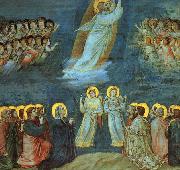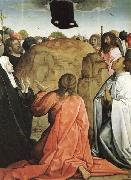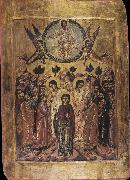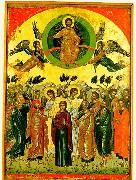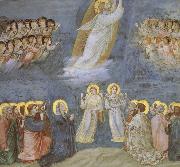Wholesale Oil Painting No Minimum |
|||||||||||
|
|
|||||||||||

|
|||||||||||
|
|
|
||||||||
GiottoItalian 1267-1337 Giotto Galleries Giotto di Bondone (c. 1267 ?C January 8, 1337), better known simply as Giotto, was an Italian painter and architect from Florence. He is generally considered the first in a line of great artists who contributed to the Italian Renaissance. Giotto's contemporary Giovanni Villani wrote that Giotto was "the most sovereign master of painting in his time, who drew all his figures and their postures according to nature. And he was given a salary by the commune [of Florence] in virtue of his talent and excellence." The later 16th century biographer Giorgio Vasari says of him "...He made a decisive break with the ...Byzantine style, and brought to life the great art of painting as we know it today, introducing the technique of drawing accurately from life, which had been neglected for more than two hundred years." Giotto's masterwork is the decoration of the Scrovegni Chapel in Padua, commonly called the Arena Chapel, completed around 1305. This fresco cycle depicts the life of the Virgin and the life of Christ. It is regarded as one of the supreme masterpieces of the Early Renaissance. That Giotto painted the Arena Chapel and that he was chosen by the commune of Florence in 1334 to design the new campanile (bell tower) of the Florence Cathedral are among the few certainties of his biography. Almost every other aspect of it is subject to controversy: his birthdate, his birthplace, his appearance, his apprenticeship, the order in which he created his works, whether or not he painted the famous frescoes at Assisi, and where he was eventually buried after his death. |
||||||||
|
|
||||||||
The Ascension
The Ascension Painting ID:: 1786 |
1305-13
Arena Chapel, Padua 1305-13 Arena Chapel, Padua |
|||||||
|
|
||||||||
Juan de FlandesFlemish-born Spanish Northern Renaissance Painter, ca.1460-1519 South Netherlandish painter, active in Spain. Nothing is known of his life or work before he went to Spain, where he is first mentioned in a document of 1496 as Juan de Flandes, a painter in the service of Queen Isabella of Castile. Treasury accounts confirm that he held this position until the Queen death in 1504. On arriving in Spain, he must have lived in Burgos, where he certainly met MICHEL SITTOW, another painter in the Queen service, who had been at the Castilian court since 1492. |
||||||||
|
|
||||||||
|
|
The Ascension
The Ascension Painting ID:: 28533 |
mk61
c.1510
Oil on canvas
110x84cm
mk61 c.1510 Oil on canvas 110x84cm |
||||||
|
|
||||||||
|
|
||||||||
|
|
The Ascension
The Ascension Painting ID:: 41911 |
mk165
around 1680
Valachia
Romania
National Art Museum of Romania
mk165 around 1680 Valachia Romania National Art Museum of Romania |
||||||
|
|
||||||||
Theophanes the Cretanactive 1527-1559,was a leading icon painter of the Cretan school in the first half of the sixteenth century, and in particular the most important figure in Greek wall-painting of the period. He was born in Heraklion (date unknown), and no doubt trained there, but all his known work was done in mainland Greece. Frescoes bearing his signature survive in the Greek monasteries of Mt. Athos, especially Stavronikita monastery and Lavra, and Meteora which has his earliest dated work, from 1527. He also did many panel icons, either for iconostases or small portable works. Theophanes was active from about 1527-48, and trained his sons and several pupils, often themselves Cretan. By 1535 both he and his two sons had become monks in the Lavra monastery of Mount Athos, where many of his best works remain. Theophanes returned to Crete before his death in 1559. Two detached wallpaintings attributed to Theophanes are in the Hermitage Museum in Saint Petersburg. Like most Cretan painters of this date, his work shows some influence from Western painting, but less in his case than with many artists. Some faces are personalised or looking out to the viewer, and his figures are modelled to convey volume. His work is more conscious of visual perspective than older Byzantine artists, but he does not use the geometrical perspective schemes by then standard in the West. He uses traditional Byzantine compositions, in a rather austere and powerful manner. He should not be confused with Theophanes the Greek (Feofan Grek), an icon painter who worked in Muscovite Russia in the late fourteenth century. |
||||||||
|
|
||||||||
|
|
The Ascension
The Ascension Painting ID:: 43668 |
Egg tempera on wood,
54 x 39 cm Egg tempera on wood, 54 x 39 cm |
||||||
|
|
||||||||
GiottoItalian 1267-1337 Giotto Galleries Giotto di Bondone (c. 1267 ?C January 8, 1337), better known simply as Giotto, was an Italian painter and architect from Florence. He is generally considered the first in a line of great artists who contributed to the Italian Renaissance. Giotto's contemporary Giovanni Villani wrote that Giotto was "the most sovereign master of painting in his time, who drew all his figures and their postures according to nature. And he was given a salary by the commune [of Florence] in virtue of his talent and excellence." The later 16th century biographer Giorgio Vasari says of him "...He made a decisive break with the ...Byzantine style, and brought to life the great art of painting as we know it today, introducing the technique of drawing accurately from life, which had been neglected for more than two hundred years." Giotto's masterwork is the decoration of the Scrovegni Chapel in Padua, commonly called the Arena Chapel, completed around 1305. This fresco cycle depicts the life of the Virgin and the life of Christ. It is regarded as one of the supreme masterpieces of the Early Renaissance. That Giotto painted the Arena Chapel and that he was chosen by the commune of Florence in 1334 to design the new campanile (bell tower) of the Florence Cathedral are among the few certainties of his biography. Almost every other aspect of it is subject to controversy: his birthdate, his birthplace, his appearance, his apprenticeship, the order in which he created his works, whether or not he painted the famous frescoes at Assisi, and where he was eventually buried after his death. |
||||||||
|
|
||||||||
|
|
The Ascension
The Ascension Painting ID:: 51702 |
nn09
c.1305-13
nn09 c.1305-13 |
||||||
|
|
||||||||
|
Giotto Italian 1267-1337 Giotto Galleries Giotto di Bondone (c. 1267 ?C January 8, 1337), better known simply as Giotto, was an Italian painter and architect from Florence. He is generally considered the first in a line of great artists who contributed to the Italian Renaissance. Giotto's contemporary Giovanni Villani wrote that Giotto was "the most sovereign master of painting in his time, who drew all his figures and their postures according to nature. And he was given a salary by the commune [of Florence] in virtue of his talent and excellence." The later 16th century biographer Giorgio Vasari says of him "...He made a decisive break with the ...Byzantine style, and brought to life the great art of painting as we know it today, introducing the technique of drawing accurately from life, which had been neglected for more than two hundred years." Giotto's masterwork is the decoration of the Scrovegni Chapel in Padua, commonly called the Arena Chapel, completed around 1305. This fresco cycle depicts the life of the Virgin and the life of Christ. It is regarded as one of the supreme masterpieces of the Early Renaissance. That Giotto painted the Arena Chapel and that he was chosen by the commune of Florence in 1334 to design the new campanile (bell tower) of the Florence Cathedral are among the few certainties of his biography. Almost every other aspect of it is subject to controversy: his birthdate, his birthplace, his appearance, his apprenticeship, the order in which he created his works, whether or not he painted the famous frescoes at Assisi, and where he was eventually buried after his death. The Ascension nn09 c.1305-13 |
||||||||
|
|
||||||||
|
Prev Next
|
||||||||
|
|
||||||||
|
Related Paintings to Giotto :. |
||||||||
|
|
||||||||
|
CONTACT US |
